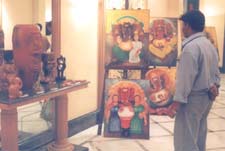A Brush With God

A Brush With God is an event that took place between 22-Aug-2001 and 25-Aug-2001 in Hyderabad.
-
Venue
-
Date/Time
-
Type
-
Price
-
Venue Website
-
Add New Field:
REVIEW FOR A BRUSH WITH GOD
Mythical idioms in modern Indian art are a common feature. In fact the artists incorporate these with a zealousness that has been engendered by the spirit of nationalism. But even before contemporary artists found a cause to absorb the ethos of India, traditionalists had been thriving upon our rich mythology, an endorsement of the patron and the public that encouraged the artists/craftsmen to amplify the richness of their works through the myriad forms of Indian arts.
From the Patachitras of Orissa to the Kalamkari medium of Andhra Pradesh, the Cherial scrolls of Warangal to the Tanjore paintings of Tamil Nadu and the innumerable forms of miniatures, Hindu mythology sustains the fabric of our arts. In fact, if we attempt to study closely, traditional visual art practices have always been an exercise towards illustrating religious mythology pertaining to the faith of the region - a similarity that can also be associated with that of the Western art practices of the Middle Ages. In fact, even tribal art is a manner of a religious commitment organized as a form of worship.
But seeing the decorative or the aesthetical nuances in such art forms (tribal, especially) is a totally urban thing, where people in the city view fragmented elements of the arts in a displaced time and space. 'A Brush with God', an exhibition of paintings and sculptures curated by Pratima Sagar for Rasa and the ITC Kakatiya Sheraton Hotel and Towers, aspires to find a balance between faith and art.
The use of Ganesh as the theme during the festivities of Ganesh Chaturthi by contemporary artists opens up an issue generally discussed by cultural theorists - the issue of popular iconography in fine arts. But even before one can broach upon this issue, the subject is rejected, as the fervor with which the innumerable Ganeshas were painted and sculpted by the 14 participating artists projected a display of design coated by an appeal for approval.
The works of V V Swamy, Stanley Suresh, Ekka Yadagiri Rao, Rangan Bhattachary, Sanjay Ashtaputre and Laxman Aelay are more or less conservative, with the scope for experimentation consciously avoided. Said Stanley Suresh, "It's best not to distort the gods for it may hurt the sentiments of the believers."
Contouring the elephant-headed god in their individualistic styles, this set of artists played more with the palette and very little with the form. Well, such a careful decision of working out an accepted image or illustrating an existing image will merely inundate the plastic arts which stipulate it to just picture making.
Another set of artists like Kavita Deuskar, Lakshmi Reddy and Pratima Sagar exhibited a variance in medium and style. Deuskar's Ganesh and Lakshmi in the reverse medium of glass were resplendent frames where the mode of flat painting with gold and black lining enhanced the richness of the physicality of the gods. Lakshmi Reddy's works in terracotta and batik were quite interesting as she played with the rawness of the medium, molding the form with a degree of sincerity and simplicity. Pratima Sagar's wet clay baby Ganesh (which she molded just before the inaugural) is a lovable lump.
Sisir Sahana's work in molded glass was yet another variance in medium display. And Chandana Khan's Ganesh in mixed media was more or less an amateurish translation of her talent.
The work that absolutely stood out was that of Jangad Singh (courtesy The Jagdish And Kamala Mittal Museum), a folk artist from MP who recently committed suicide in Japan (he had not been given a clearance to leave the country after he had gone there for an art program). His drawing is an organic formation of Ganesh, which rises out of the linear composition.
Then the tantric genre of Ganesh placement by the late P T Reddy and the muted work of the late Vidya Bhushan were received well. The lyrical drawing or book illustration of K Seshagiri Rao was yet another exhibit that enhanced the range of Ganeshs on display in the corridors of the star hotel.
The inaugural evening was a fusion of music and the visual form. Venu Madhav performed the 'Ganesh Vandana' in the Carnatic style.
AA
USER REVIEWS FOR A BRUSH WITH GOD
Be the first to comment on A Brush With God! Just use the simple form below.
LEAVE A COMMENT
fullhyd.com has 700,000+ monthly visits. Tell Hyderabad what you feel about A Brush With God!
MORE EVENTS IN THIS PERIOD
ALL EVENT CATEGORIES
SEARCH EVENTS
Dissatisfied with the results? Report a problem or error, or add a listing.
ADVERTISEMENT
SHOUTBOX!
{{ todo.summary }}... expand »
{{ todo.text }}
« collapse
First | Prev |
1 2 3
{{current_page-1}} {{current_page}} {{current_page+1}}
{{last_page-2}} {{last_page-1}} {{last_page}}
| Next | Last
{{todos[0].name}}
{{todos[0].text}}
ADVERTISEMENT
This page was tagged for
ITC Kakatiya Sheraton Hotels & Towers events
August 2001 events
hyderabad arts
hyderabad exhibitions
hyderabad paintings